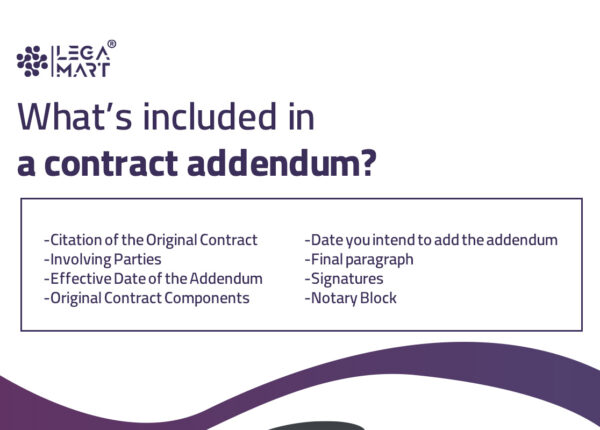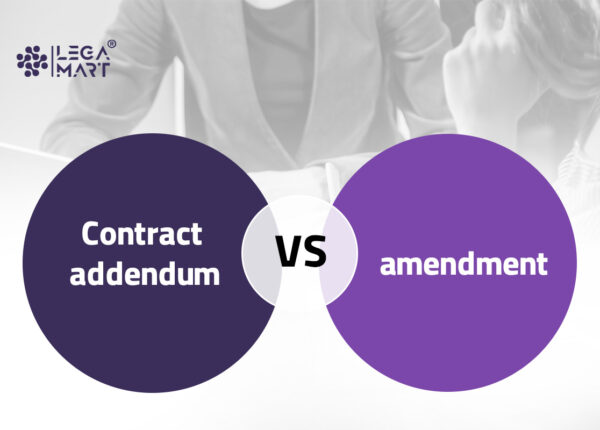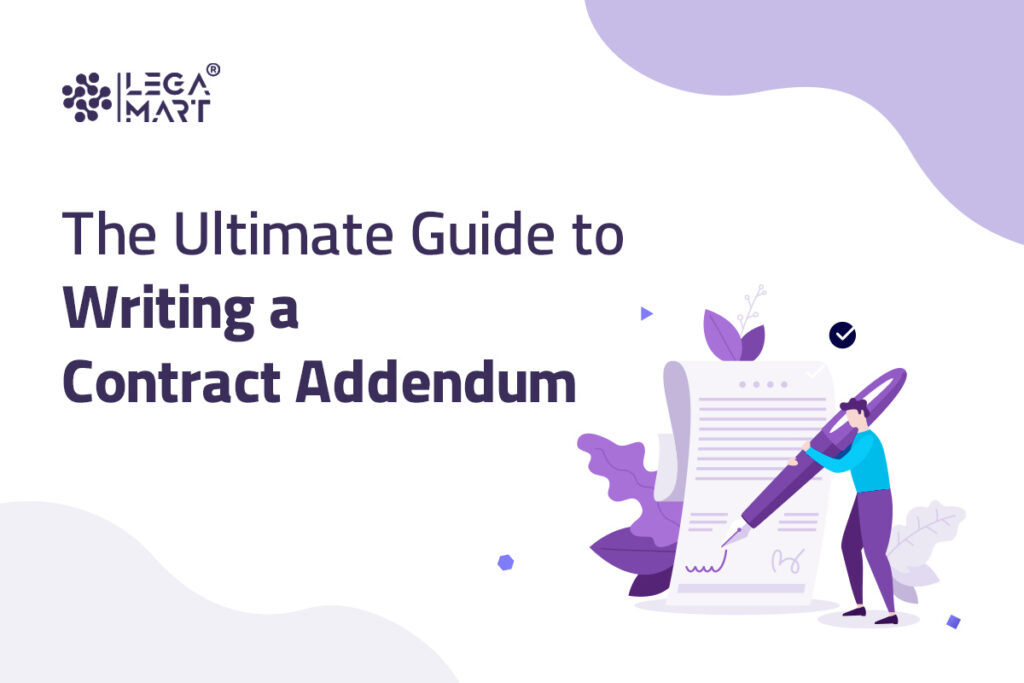Introduction
When navigating the complexities of contractual agreements within Legal Practice & Specialization, the need for precision often arises, leading to the inclusion of addendums to address modifications or additions. A contract addendum is a simple way to expand on an existing contract. An addendum to a legal contract is any document added after the signing of the agreement to amend its provisions while leaving the remainder of the warranty intact. It serves as a supplemental document, providing clarity and adjustments to the terms of the original contract. This is sometimes known as a contract amendment or an amending deal; however, an amendment is usually done without needing a separate document.
Whether you are considering proposing an addendum or seeking guidance on interpreting and executing one, our qualified legal professionals can provide invaluable assistance. With a commitment to ensuring legal soundness and alignment with your specific requirements, Legamart lawyers are adept at navigating the intricacies of addendums to enhance the robustness of your contractual arrangements. So what exactly is an addendum to a contract, and when should you use one? This article will provide you with basic knowledge of contract addendums.
What is a contract addendum?

A contract addendum, also known as an amending agreement, is a document frequently appended to an existing legal instrument after it has been modified. Once a contract has been signed, it may be hard to make changes without tainting the agreement. A contract addendum is used to accommodate any additional changes to such initial agreements.
Ideally, the contract addendum guarantees that changes to the original contract are made while keeping it intact. Furthermore, the contract addendum is legally binding. Contract addendums function as post-contract attachments, allowing you to change or amend any earlier provisions in a current contract.
That signifies that adding anything new to an existing contract is feasible. Contract addendums should include the signatures of all parties to the underlying contract in a legal environment.
Types of addendums
There are many distinct addendums since they are attached to a contract. For example, you can add a supplement if you have drafted a will but want to avoid creating it because you only want to amend select portions. The addition might alter your list of heirs, the sums to be dispersed, or any other clauses you choose to modify.
A real estate addendum amends a lease or purchase agreement. Items in the addendum might indicate a change in the agreed-upon price, what is included in the property transfer, what renovations must be completed before the home is paid for, or any other agreed-upon demands or duties.
An amendment in insurance contract would add or remove what is covered in an insurance policy’s coverage. An insurance supplement may result in a change in insurance premiums. Insurance addendums are prevalent since most insurance plans are standard, yet typical policies may only be appropriate for some. An insurance addendum can adapt a basic insurance policy to a specific person.
Steps to Drafting a Contract Addendum
Crafting an effective addendum to a contract doesn’t have to be complex. Follow these straightforward steps to ensure clarity and legal validity:
- Mirror Original Contract Language: Consider the language, formatting, layout, font size, and style of the original contract. Match these aspects in your addendum to emphasize its importance and relevance.
- Choose an Informative Addendum Title: Create a title referencing the original agreement’s name and date. Clearly state that it is an addendum to the specific contract.
- Specify Involved Parties: Clearly identify the parties involved, usually mirroring those in the original contract. Explicitly state any involvement of a third party if applicable.
- Clarify the Reference in the Original Contract: Define the specific part of the original contract that the addendum addresses. Use formatting tools like italics, bold, or strikethrough to highlight modifications.
- Ensure Compliance and Legality: Confirm that the addendum aligns with the original contract terms and complies with relevant laws. Verify compliance with jurisdictional regulations before seeking agreement.
- Incorporate Essential Elements: Include elements like the effective date, force majeure details, and a signature block. Consider adding disclaimers or other necessary clauses.
- Consider Legal Advice: Prior to presenting the addendum, consider seeking legal advice to ensure adherence to laws and regulations. Legal professionals, such as Legamart lawyers, can guide to avoid potential legal pitfalls.
Example of when to use a contract addendum

An addition can be helpful in a variety of situations. The addendum guarantees that the error is acknowledged and corrected. The amendments become legally binding as per the first contract after every party in the initial vehicle leasing agreement signs the addition.
Addendums are commonly used in the real estate industry. When a potential home buyer and seller negotiate a purchase and sale agreement, addendums give information about concerns and items not included in the initial copy. Addendums clarify relevant information when employing contingencies, such as the buyer’s ability to secure adequate financing or an as-is real estate-owned (REO) home.
A contract addendum is also used when creating an employment contract. Clauses in such agreements that may be controversial may be modified to reflect the changes. Terminating employment provision, for example, is one of the usual changes that may necessitate an addition.
For example, suppose the initial employment contract listed two conditions: death and voluntary resignation. Finally, a contract addendum may be introduced at the employer’s option to outline the workers’ tasks and exclusions.
In most cases, an employment contract is lengthy. Such critical clauses may be left out intentionally or unintentionally. The contract addendum helps to address any contract clauses that may have been left out in the initial contract. In addition, most employment agreements have gaps that may require an addendum to remedy them.
Other standard addendums may include a review of the salary. Employee contract addendums may also include amendments to the positions and roles held by specific employees.
What is included in a contract addendum?

While writing a contract addition, the final contract amendment should always consider specific terms and conditions.
Citation of the Original Contract: The name and date of the original contract are essential components in a contract amendment. By referencing the original agreement, you specify that the new document is an addition to the previous contract. As a result, the reference should include the title and a clear indication of the initial contract’s specifics.
Involving Parties: While writing the addendum, ensure all parties involved are included. The contract’s parties must be stated.
Effective Date of the Addendum: The effective date is an essential component of an appendix. Specifying the date on which the addition became legally obligatory is critical. The date format in the contract addition should be the same as the date in the original contract format when preparing the amendment.
Original Contract Components: The particular parts of the original addendum should be modified in the addendum. As a result, it’s critical to specify which portions of the original contract may need to be modified. The prior contract’s components should be followed to demonstrate the required improvements. One method of handling the changes is to use italics and bold typefaces to indicate the changes. You can also delete a particular clause.
Date you intend to add the addendum: When creating an amendment, it is critical to specify a date. When examining the final addendum, including the date will be helpful too.
Final paragraph: While creating the final addendum, the conclusion paragraph comes in handy. The last section is helpful since it assures that the addendum cannot be changed after the final full stop. A conclusion paragraph follows the modifications, signalling the end of any revisions.
Signatures: When creating a contract addition, signatures are required. At the end of the contract, include a signature block. A signature box containing places for all parties confirms that each party to the amendments has signed off on their support for the addendums.
Notary Block: The block, which includes a notary, acknowledges the sworn statement made by a notary public. The witnesses in the notary block are parties to the contract’s signature and confirmation by the addendum.
Is an addendum to a contract legally binding?

The individual who created the original document can make changes to an amendment. Alternatively, another party may change the agreement with the consent of the original signatories. When these contract revisions are made, they must be properly contract drafted as they become legally binding and serve as a basis for collaboration between the parties. Until other arrangements, the modifications made constitute part of the contract.
To confirm the contract’s legitimacy, legal counsel must even verify its provisions. However, the contract addendum will only be legally binding if both parties fully grasp the new agreement’s provisions and implications.
As a result, the parties must agree to the new alterations in writing to validate their legal standing. As a result, a contract addendum is a legally enforceable document that alters the scope and applicability of the original contract.
Contract addendum vs amendment

Most people need help distinguishing between a contract modification and a contract addition. Addendums add something new to the contract rather than simply changing the original agreement.
When all of the conditions of the addendum are agreed upon by the contract’s parties, it becomes legally binding. As a result, it’s critical to comprehend the contract addendum’s mechanics.
A contract amendment, on the other hand, may relate to a change to the original contract that improves, fixes, or clarifies any aspect of the agreement. For example, the amendment might modify the terms and conditions of a contract by changing a portion of it.
The primary distinction between the contract addendum and modification is their aim. A contract modification updates an existing provision or part. Extending a previously agreed-upon deadline, for example, is a simple modification.
On the other hand, an addendum is a document appended to the original contract. The addendum describes the changes that will be made to the original contract.
Amendments to the authority require the signing parties. Legal representatives with authority may also represent the signing parties to make the desired changes. Addendums, on the other hand, can be made by any party. Third parties are examples of such parties.
Can you add an amendment to an addendum?
Yes, it is possible to add an amendment to a pre-existing contract addendum, although it may be more efficient to amend the original contract’s scope if all parties agree.
The process of amending a contract addendum closely follows the procedure for amending a regular contract. Key recommendations include:
- Ensure Intent at Every Stage: Legally enforceable contracts or amendments require clear intent. Document and demonstrate intent wherever possible to strengthen the legal standing of the amendment.
- Document Everything in Writing: Clearly articulate the changes to the scope of the addendum in the amendment. Reference the title of the original contract to maintain clarity regarding the comprehensive scope modification.
- Secure Fresh Signatures: Obtain new signatures from all involved parties whenever amending an agreement. This practice is crucial in preventing potential legal complications in the future.
How do you write an addendum to a contract?

Drafting an amendment can be complicated and need the assistance of a lawyer. The effective date should be used to write the amendment. It is similar, using the same format and tone as the original contract.
The intended revisions are the most significant aspect of a contract amendment. As a result, while drafting the addendum, it is critical to mention the required modifications.
Conclusion
It is critical to capture all of the dynamics of an addendum. But, when done outside the legal system, appendices frequently need more essential components. A contract addendum is only legally binding if both parties fully comprehend and agree to the additional conditions in writing. All parties who signed the original contract must likewise sign the addition; if one or more parties cannot sign, they can appoint agents with the power to do so.
If you need a legally binding addendum, the LegaMart team of experienced lawyers is here to help you with all your queries and to ensure legal compliance. You can learn about LegaMart services on our homepage.
Frequently Asked Questions
When should I use a contract addendum?
Contract addendums are suitable when you need to clarify or introduce elements not initially part of the original contract. Think of addendums as additions to the initial agreement; for instance, adding a deadline that was not specified in the original version. For legal enforceability, ensure that all parties have properly executed the contracts with clear intent, signifying acknowledgment and agreement to the new scope.
Who can propose an addendum or an amendment to a contract?
Any party involved in the original contract has the authority to propose either an addendum or an amendment. However, it is crucial that all parties, including the proposing party, reach a unanimous agreement on the proposed changes. This collaborative process involves negotiation and discussion, mirroring the initial contract negotiation procedure.
Are there any specific provisions in contracts regarding amendments or addendums?
Some contracts may include specific provisions outlining the process for making amendments or addendums. In such cases, it is essential to adhere to the terms stipulated in the contract. Following the contract’s guidelines ensures a structured and legally sound approach to implementing changes in the agreement.




